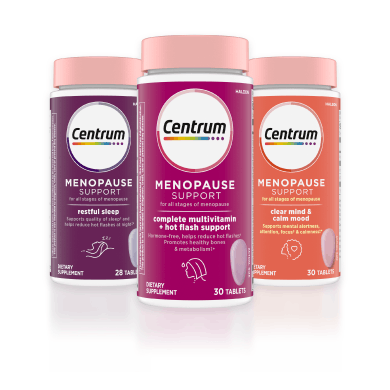What Happens During Menopause?
Menopause has three stages – premenopause, perimenopause and postmenopause.
Often, perimenopause and postmenopause are collectively referred to as menopause, but technically, you are "in menopause" when you've had one year without a period.

Perimenopause, meaning "around menopause," varies in duration but averages about four years. During this time, your periods will become irregular in length and flow and your cycle length will change. This is also the time when you may start to experience symptoms related to fluctuating hormone levels.
Hot Flashes
Hot flashes are among the most well-known menopause symptoms—about 80% of women experience them at some point. These sudden bursts of heat cause a temporary increase in body temperature that leads to flushing and sweating in the chest, neck and face.
Night sweats, hot flashes that occur during sleep, can start to disrupt your rest. Hot flashes and night sweats are often triggered by spicy food, alcohol, caffeine, stress and anxiety. They can also be worsened by smoking, diet and having a larger body size. Research shows that ethnicity can also influence hot flashes, with Black women experiencing more severe and long-lasting hot flashes.
Vaginal Dryness
Menopause causes almost every woman to experience some degree of vaginal dryness and thinning of the vaginal tissues. In addition, you may experience pain with vaginal penetration and increased risk of vaginal and urinary tract infections. Some people experience vaginal bleeding from small injuries in these tissues.
Estrogen plays a vital role in the health and function of the vaginal tissues and the healthy balance of bacteria and yeast in the vagina. When hormones decrease, the environment changes and becomes more easily irritated. These symptoms, collectively known as genitourinary syndrome of menopause (GSM), are reported by up to 90% of postmenopausal women—but the true number could be higher.
The good news is that there are several highly effective strategies for managing GSM. Make sure to follow Midday’s vaginal dryness program if you’re struggling with these symptoms. Find it on the Programs page under Manage My Symptoms. Inform your doctor of any significant vaginal bleeding to rule out other potential causes, including abnormalities in the ovaries or uterus.
Weight Gain
Many women notice weight gain around the waist as they enter menopause, even with no significant changes in their diet and exercise.
Estrogen influences metabolism and weight regulation. Without the addition of muscle-building exercise, aging also causes a natural decrease in muscle mass.
Over time, change in body composition slows your metabolism and causes abdominal and visceral fat (fat around the organs) to increase.
Weight gain and increased body fat are not inevitable, but it does mean you have to make changes in your nutrition and exercise if you’re looking to stave off this process.
Cardiovascular Risk
Heart disease is the leading cause of death for women over 50. A loss of estrogen around menopause plays a major role in this increased risk.
Entering menopause typically causes levels of “bad” low-density lipoprotein (LDL) cholesterol to rise.
Declining estrogen can also lead to inflexible blood vessel walls, which increase the risk of atherosclerosis (plaque buildup on vessel walls) and cardiovascular disease in menopausal women.
If you already have an elevated risk of heart disease due to family or personal health history, it’s important to be proactive about your heart health around menopause. Talk to your healthcare provider about the right diet, exercise and medication support for you.
Bone Health
The biggest single risk factor for developing osteoporosis (very low bone density) is being a postmenopausal woman. Bone density is built up until about age 35, at which point it begins to gradually decline. However, the drop in estrogen levels around menopause causes a steep drop off in bone density—you lose up to 10% of your bone density in the five years after menopause.
Changing the trajectory of your bone health starts now. Menopausal hormone therapy shows potential in protecting against bone loss and medications for low bone density may be a good idea for you depending on your risks.
However, all women should protect and strengthen their bones with nutrition and exercise. Eat a diet rich in calcium and protein and get enough vitamin D. Participate in regular weight-bearing movement, impact activities and strength training with heavy weights.
A New Beginning
While perimenopause lasts for several years, postmenopause is for the rest of your life. While some changes that come from lower estrogen levels may be welcome (no more periods!), others like changing health risks can be more challenging to accept.
Your health trajectory is not inevitable. Making small changes adds up to large shifts over time in the elements of your lifestyle that make a major difference in your long-term health and wellness.
Resources like Midday are here to help you along the way. Menopause can be a time of liberation and happiness. With the right support, you can lead a healthy and joyful life for many years to come.













